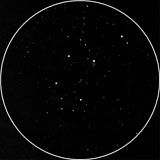
| MESSIER 45, THE PLEIADS |
|---|
RA: |
03h 47m 00s |
|
DEC: |
+24° 07' 00'' |
|
Type: |
Open cluster imbedded in nebulousity |
|
NGC: |
||
Magnitude: |
1.60 |
|
Surface brightness : |
||
Apparent dimensions : |
110'x110' |
|
Distance: |
440 ly |
|
The Pleiades also known as M45 or the Seven Sisters - is the name of an open cluster in the constellation of Taurus. It is among the nearest to the Earth of all open clusters, probably the best known and certainly the most striking to the naked eye. This asterism is sometimes referred to as the Maia Nebula, perhaps erroneously considering that the reflection nebulosity surrounding Maia is extrinsic. The cluster is dominated by hot blue stars, which have formed within the last 100 million years. Dust that forms faint reflection nebulosity around the brightest stars was thought at first to be left over from the formation of the cluster but is now known to be an unrelated dust cloud that the stars are currently passing through. Astronomers estimate that the cluster will survive for about another 250 million years, when it will have dispersed due to gravitational interactions with the spiral arms of the galaxy and giant molecular clouds. The cluster is about 12 light years in diameter and contains approximately 500 stars in total. It is dominated by young, hot blue stars, up to 14 of which can be seen with the naked eye depending on local observing conditions. The arrangement of the brightest stars is somewhat similar to Ursa Major and Ursa Minor. The cluster contains many brown dwarfs, which are objects with less than about 8% of the Sun's mass, not heavy enough for nuclear fusion reactions to start in their cores and become proper stars. They may constitute up to 25% of the total population of the cluster, although they contribute less than 2% of the total mass. Also present in the cluster are several white dwarfs. Given the young age of the cluster normal stars are not expected to have had time to evolve into white dwarfs, a process which normally takes several billion years. It is believed that, rather than being individual low- to intermediate-mass stars, the progenitors of the white dwarfs must have been high-mass stars in binary systems. Transfer of mass from the higher-mass star to its companion during its rapid evolution would result in a much quicker route to the formation of a white dwarf, although the details of this supposed transfer from a deeper gravity well to a lesser are unexplained. Ages for star clusters can be estimated by comparing the H-R diagram for the cluster with theoretical models of stellar evolution, and using this technique, ages for the Pleiades of between 75 and 150 million years have been estimated. The spread in estimated ages is a result of uncertainties in stellar evolution models. The cluster's relative motion will eventually lead it to be located, as seen from Earth many millennia in the future, passing below the feet of what is currently the constellation of Orion. Also, like most open clusters, the Pleiades will not stay gravitationally bound forever, as some component stars will be ejected after close encounters and others will be stripped by tidal gravitational fields. Calculations suggest that the cluster will take about 250 million years to disperse, with gravitational interactions with giant molecular clouds and the spiral arms of the galaxy also hastening its demise. Under ideal observing conditions, some hint of nebulosity may be seen around the cluster, and this shows up in long-exposure photographs. It is a reflection nebula, caused by dust reflecting the blue light of the hot, young stars. It was formerly thought that the dust was left over from the formation of the cluster, but at the age of about 100 million years generally accepted for the cluster, almost all the dust originally present would have been dispersed by radiation pressure. Instead, it seems that the cluster is simply passing through a particularly dusty region of the interstellar medium. The nine brightest stars of the Pleiades are named for the Seven Sisters of Greek mythology: Sterope, Merope, Electra, Maia, Taygete, Celaeno and Alcyone, along with their parents Atlas and Pleione. Even with the naked eye and under modest conditions, the Pleiades are rather easily found, roughly 10 degrees north-west of the bright red-giant star Aldebaran (87 Alpha Tauri, mag 0.9, spectral type K5 III). Apparently surrounding Aldebaran is another, equally famous open cluster, the Hyades; Aldebaran is known to be a non-member foreground star (at 68 light years distance, compared to 150 ly for the Hyades). As the Pleiades are situated close to the ecliptic (4 degrees off), occultations of the cluster by the Moon occur quite frequently: This is a very appealing spectacle, especially for amateurs with less expensive equipment. Also, planets come close to the Pleiades cluster (Venus, Mars, and Mercury even occasionally pass through) to give a conspicuous spectacle. |
||
Other sketches |
|||||
 |
|||||
M45, 80x, Oct 2006. |
|||||
VEDRAN VRHOVAC© 2006.-2007. |
